ALDERSHOT, HAMPSHIRE
The postmark on the back of the postcard below, showing various views of Aldershot, Hampshire, indicates that it was posted in 1915. The five small images show, moving clockwise from top left, the Cambridge Hospital; the RAMC (Royal Army Medical Corps) Memorial; the High Street; and Grosvenor Road; in the centre is the Wellington Statue. Called the ‘home of the British Army’, soldiers and their families have been based at Aldershot since the mid-1850s, which means that generations of army children will have been familiar with these landmarks. Click here for Hampshire County Council’s outline of the history of the camps and barracks at Aldershot.

The postcard below shows a church parade photographed on Wellington Avenue at the start of the twentieth century.
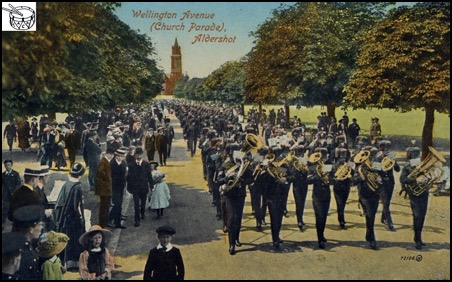
The colourful postcard below was first published by Raphael Tuck & Sons in 1908. It shows a church parade outside All Saints Church (also known as the Royal Garrison Church of All Saints) in Aldershot, with civilian men and women by the roadside, no doubt many army children among them.
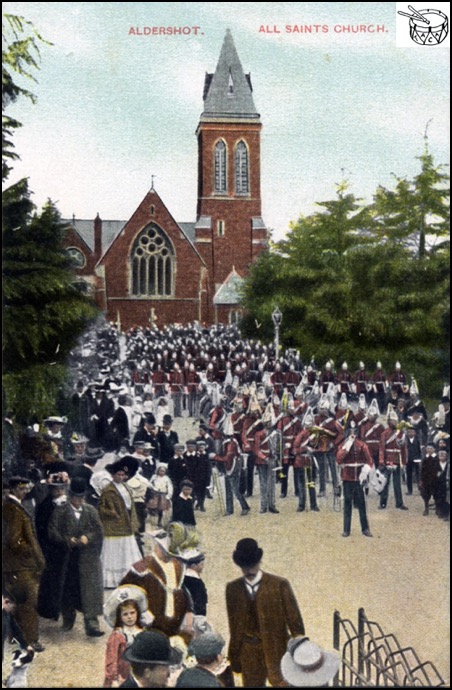
The sepia-toned multiview postcard reproduced below sends ‘Greetings from Aldershot’. At the centre is a shot of ‘The N.A.A.F.I.’, while the remaining four photographs show, moving clockwise from top right, ‘Municipal Gardens’, ‘Bathing Pool’, ‘The Royal Garrison Church’ and ‘Queens Avenue’. Also on the front is the code ‘Ald 58’, suggesting that this, a Frith’s Series card, dates from the 1950s. Click here to see more Frith postcards of Aldershot.

BULFORD, WILTSHIRE
Bulford Camp was established at the end of the nineteenth century, becoming home primarily to the Royal Artillery over the next eighty years. To start with, the camp consisted of tents and huts, with brick barracks gradually being constructed from around 1910.

Above: An early bird's-eye view of Bulford Camp, on Salisbury Plain.
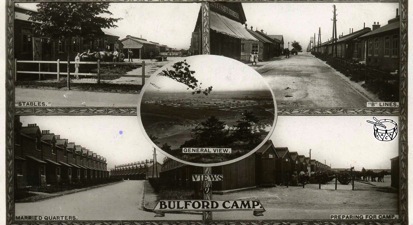
Above: A postcard showing views of Bulford Camp dating from around World War I. Clockwise from top left: stables, 'B' lines, preparing for camp, married quarters; the central image offers a general view of the camp.
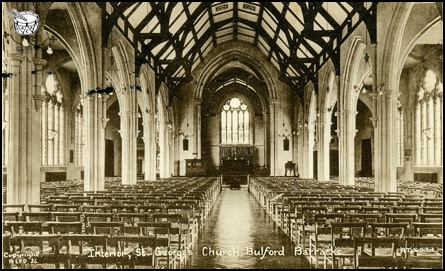
Above: This sepia-toned postcard, which was posted during the reign of George VI – i.e., between 1936 and 1952 (the postmark is unclear) – shows the interior of St George’s Church, Bulford Barracks, Wiltshire. Constructed between 1920 and 1927, St George’s was first the camp and then the garrison church, which it remains. As such, generations of army children have attended it, also being baptised and confirmed there.
BURY, LANCASHIRE
The old colour postcard below, which was posted in 1905, shows the Wellington Hotel (foreground) and, beyond it, Wellington Barracks, in Bury, Lancashire. Wellington Barracks, in Bolton Road, dates from 1845 and served as the Lancashire Fusiliers’ regimental depot from 1881 and later as the regiment’s headquarters. The site has recently been redeveloped as offices.
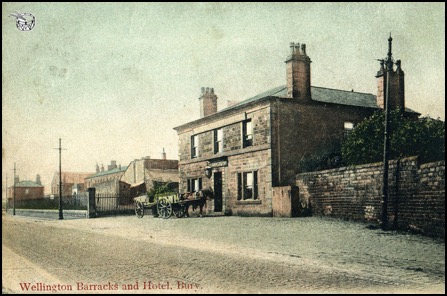
CATTERICK, NORTH YORKSHIRE
One of the lines of printed information on the back of the ‘sepiatone’ postcard of Catterick Camp, below, states, ‘Passed for publication by the Press Censor, Sept. 6th. 1917’.
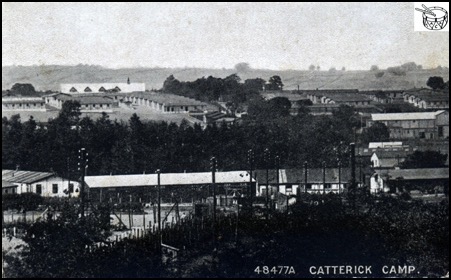
Like its fellow above (that being numbered 48477A, while this one’s reference number is 48477B), the postcard below was ‘Passed for publication by the Press Censor, September, 1917’. Both show views of Catterick Camp, as Catterick Garrison was then called, and both were published by Photochrom Co Ltd, of London and Tunbridge Wells.
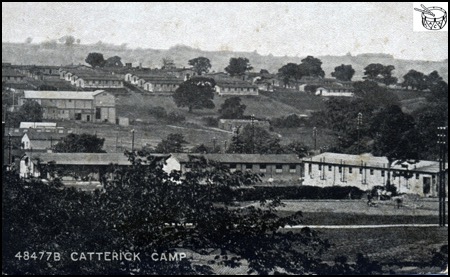
An overview of Catterick Camp, which was renamed Catterick Garrison in 1973, takes centre stage in the postcard below. A view of Sandes Soldiers Home appears top right; the post office can be seen bottom right; the garrison theatre is pictured bottom left; and a snapshot of Boulogne Lines is positioned top left. The style of the vehicles visible in the photograph of Boulogne Lines suggests that army children who lived in Catterick Camp around the time of World War II would have been familiar with these scenes.
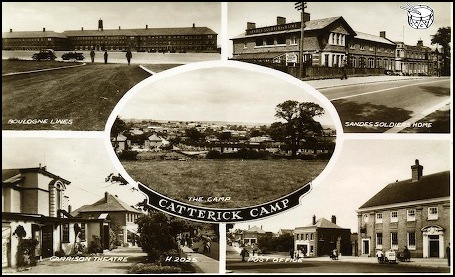
CHATHAM, KENT

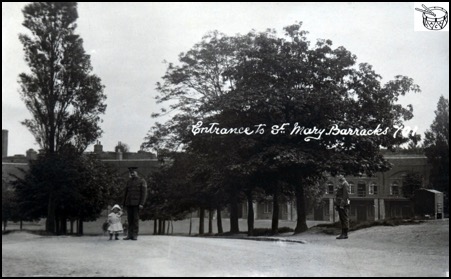
DEEPCUT, SURREY
The multi-view postcard below dates from around 1906, and shows aspects of the army camp at Deepcut (here spelled as two words), Surrey, where Royal Field Artillery (RFA) soldiers and their families were based. The scenes that it depicts, moving clockwise from top right, are labelled ‘married men’s quarters’; ‘R.F.A. in action’; ‘Deep Cut Bridge’; ‘R.F.A. gunners at work’; and ‘Garrison Church’. Click here for a colour version of the married-quarters’ view.

SHORNCLIFFE, KENT
The black-and-white postcard reproduced below was posted in 1905. It shows the barracks and institute at Shorncliffe, near Folkestone, in Kent. According to the 1903 edition of Kelly’s Directory of Kent, ‘SHORNCLIFFE, in this parish [of Sandgate], is one of the most important military stations in the kingdom; the camp, permanently re-established in 1854 [the army camp dates from 1794] on an elevated and extensive plateau above the town, overlooking the sea, forms three sides of a square and is arranged for several thousand troops: there are detached blocks of modern brick buildings, including officers' quarters and messes, married men’s quarters, schools, Church of England place of worship, and Catholic chapels erected in 1894 and dedicated to the Holy Name, libraries, recreation rooms, besides Church institute and hospital.’

The postcard below shows crowds outside the garrison church at Shorncliffe, some time during the early years of the twentieth century.
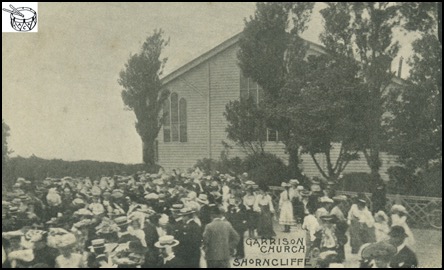
TIDWORTH, WILTSHIRE

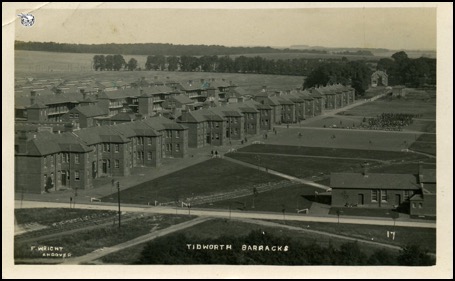
The postcard reproduced below shows Assaye Barracks, in Tidworth, Wiltshire, around a century ago. Assaye Barracks was named after a famous battle fought in India in 1803, the commander of the victorious army being Major General Arthur Wellesley, the future Duke of Wellington.

The black-and-white postcard below, which dates from the first quarter of the twentieth century, shows the interior of the garrison market in Lucknow Barracks, Tidworth, Wiltshire, with army children visible among the soldiers and market stalls. The sender of the postcard – ‘Jack’ – has described Tidworth Garrison on the reverse:
‘There are churches, stores of every kind – in fact it is a regular town in itself, with even theatres. There are married men’s quarters, and some families still live here, the children going to school right in the barracks. You couldn’t imagine such a place – a regular little town.’

Judging by the style of the cars, the colour postcard below dates from the 1960s or 1970s. It shows four views of the garrison town of Tidworth. Moving clockwise from top left, they are: Zouch Parade; Old Chancery, South Tidworth; Tidworth Garrison Golf Club; and St Michael’s Garrison Church.
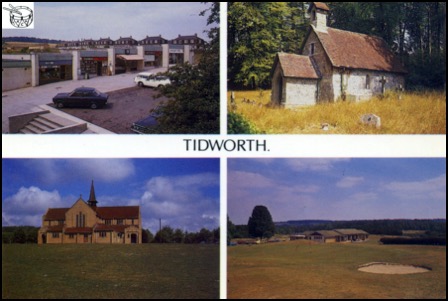
WOOLWICH, SOUTH-EAST LONDON
The postcard below shows aspects of Woolwich, in south-east London, the one-time headquarters of the Royal Artillery, photographed around a century ago. The central image is labelled ‘Arsenal main gate’, with ‘Powis Street’ appearing bottom right, followed, moving clockwise, by ‘Ferry’, Wellington Street’, R.M. [Royal Military] Academy’, ‘Green Hill Battery’ and ‘Garrison church parade’. The church that can be seen looming behind the parading soldiers is St George’s Chapel, the Royal Artillery’s garrison church on Grand Depot Road, Woolwich, which many army children once attended with their parents. Designed by architect T H Wyatt, and dating from 1863, a direct hit by a V1 flying bomb on 13 July 1944 left only the apse. A grant has recently been awarded by the Heritage Lottery Fund towards a new roof, as well as to safeguard a memorial listing Royal Artillery recipients of the Victoria Cross and some notable mosaics. Click here for further information about the repair plans.
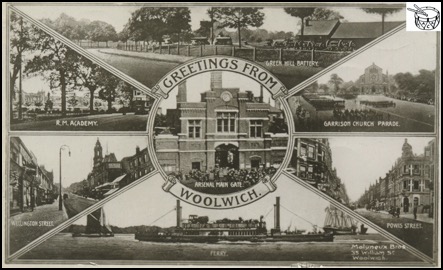
Children number among those watching a garrison church parade at Woolwich some time during the early years of the twentieth century, judging by the style of clothes worn by the spectators in the postcard below. The church in the background is St George’s Church, the Royal Artillery’s garrison church, which was erected in 1863.
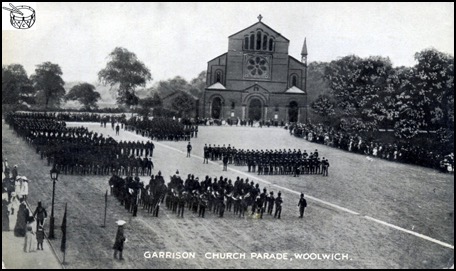
The postcard below was posted in 1915 by Gunner Cornhill, of the Royal Field Artillery (RFA), from the married quarters at Brook Hill in Woolwich, southeast London. It shows various scenes of Woolwich: moving clockwise from bottom left, the ‘free ferry’, the Rotunda, the Indian Gun, ‘among the pines at Bostall Woods’, St Margarets, the Royal Artillery Barracks (which was constructed between the late eighteenth and early nineteenth centuries alongside Woolwich Common) and Beresford Square. Click here for a postcard showing married quarters in Woolwich; throughout the TACA website, you’ll also find a number of contributors’ recollections of growing up in Woolwich as army children.


